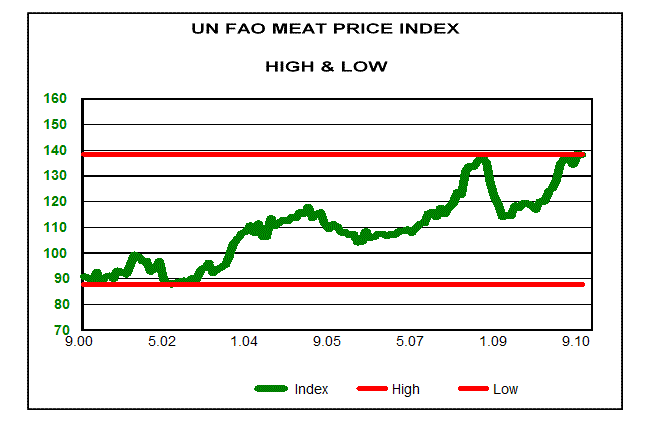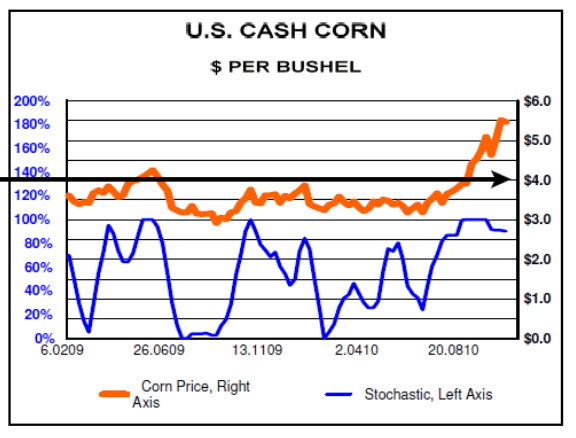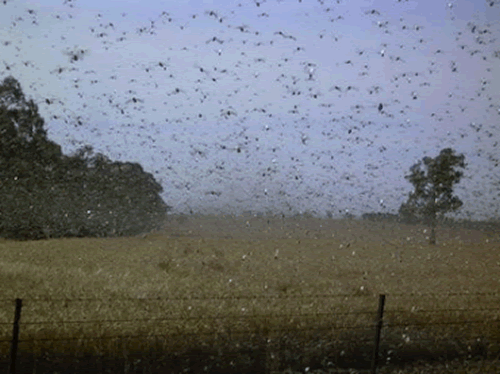Food Prices Spiraling Higher, Grains Feed Meat Prices
Commodities / Agricultural Commodities Oct 21, 2010 - 05:23 AM GMTBy: Ned_W_Schmidt
 Businesses, be they purveyors of adult beverages or farms, are different from governments. Governments can, in most cases, print money to pay their expenses, or borrow near unlimited amounts to do so. Businesses, however, must take in sufficient money to cover their input costs, the expenses of labor, and earn a fair return on their invested capital. If current prices do not allow for that, the price of the business's service or products must rise.
Businesses, be they purveyors of adult beverages or farms, are different from governments. Governments can, in most cases, print money to pay their expenses, or borrow near unlimited amounts to do so. Businesses, however, must take in sufficient money to cover their input costs, the expenses of labor, and earn a fair return on their invested capital. If current prices do not allow for that, the price of the business's service or products must rise.
In Agri-Food raising animals for meat is no different, though the path to higher prices is often not direct. Grain prices have clearly demonstrated that a new norm exists for the range in which they will trade. Era of cheap grains is now a foot note in history texts. Those higher grain prices mean higher feed costs to animal feeding operations. While those higher costs should lead to higher meat prices, just the opposite happens first.

In the above chart is plotted the UN FAO's meat price index, which recently rose to a new high. That new high, though, relates not to today's higher grain prices, but to the higher grain prices of two years ago. When grain prices rise, rather than absorb the higher costs, animal feeders move to reduce their animal count. They sell them, rather than feed them. That selling pushes down meat prices temporarily. For that reason, meat prices in 2008 did not spike upward to the same extent as did grain prices.
Almost two years have been required to reduce animal head counts to the level that would sustain higher meat prices. Such is the reason that meat prices rose to a new high in the above chart. With the recent rally in global Agri-Grain prices, another round of reduction in animal head counts should develop. While that development is depressing meat prices currently, we can look forward to meat prices rising to news highs throughout 2011. Today's meat prices are a bargain relative to that which will prevail in 2012.
An integral part of the above dynamics is the price of corn, portrayed in the chart below. Corn is now operating in the price inelastic portion of the long-run supply curve. That implies two things. First, US$4 is the new floor for corn prices. Second, small increase in demand results in greater percentage increase in prices. As no new corn will be produced in North America till September 2011, price of corn can move far more than many expect. Given this situation, a forecast of $7 corn in late 2011 is neither bold nor unrealistic.


When last we talked, part of our discussion was on the locust swarms emerging in Australia. Thought some might like to see a picture of what some Australian farmers are facing. Thanks to AP, we have the following picture.
From "Locusts May Curb Australia's Wheat Exports, Commodore Research Forecasts" by W. Pugh at Bloomberg News, 14 Oct, we read that Australian wheat harvest will fall short of expectations by more than 3 million tons,
"Wheat shipments from Australia, the fourth-largest exporter, may be little changed this year and miss a government forecast because a locust plague may harm the harvest, according to Commodore Research & Consultancy."
"Shipments may be 15 million to 16 million metric tons in 2010-2011 compared to about 15 million tons last marketing year, the New York-based group said in an e-mailed report. The Australian Bureau of Agricultural & Resource Economics-Bureau of Rural Sciences forecast on Sept. 14 that exports may rise to 18.4 million tons, the second-highest level on record."
"A miss of the government forecast may help to sustain wheat's 30 percent rally this year,"
As wheat is not produced in a factory in Australia, this lost harvest will not be made up till this time next year, 2011.
Investors have now begun to recognize that a structural shift is taking place in Agri-Foods. Recent higher grain prices have translated into higher prices for Agri-Equities. As most investors do not venture into the market for futures, they have pursued proxies. Tractor stocks, for example, have served as proxies for grains, as have fertilizer companies.
Pursuit of those equities may have pushed those grain proxies to over extended prices. A reasonable case might be made that some weakening in Agri-Equity prices might develop in the remainder of this year. Investors should use such a period of calm to do research to prepare for the next leg of the Agri-Food Decade.
Aside from the perhaps over extended nature of Agri-Equities at this time, two other factors may combine to create a buying opportunity in the months ahead. First, North American harvest is about complete, in near record time. While that harvest is not as large as expected, it has been collected in rapid fashion and in good condition. That situation may serve to cap further increases in prices for a number of weeks.
Second, and perhaps more important, is the recent move to raise interest rates by China. Weak U.S. dollar has been a strong stimulant to sales of North American Agri-Foods. Weak dollar makes U.S. Agri-Food commodities cheaper, on relative basis, in world markets. U.S. Agri-Exports have been inordinately strong. Further, the weak dollar had also raised price expectations of grain traders.
One ramification of the Chinese rate increase was that the U.S. dollar rallied strongly. As the Chinese Yuan and the U.S. dollar are still connected, though in looser fashion, an increase in Chinese interest rates should increase the value of the Chinese Yuan and the U.S. dollar. A stronger U.S. dollar will lower demand somewhat for U.S. Agri-Food commodities. Stronger though may be the potential to dampen the enthusiasm of grain traders..
Investors, as suggested above, should use the remainder of the year to research the Agri-Food Decade now unfolding. This opportunity exists for many reasons, but in part due to investors not understanding that Agri-Foods are not produced in factories. They are produced in dirt one time year, and with great uncertainty. Part of this learning process is to come to understand that Agri-Food commodities are operating in the price inelastic portion of the long-run supply curve. A good starting point is this report http://www.agrifoodvalueview.com/files/Joy_of_Agri-Food_Price_Inelasticity.pdf
By Ned W Schmidt CFA, CEBS
AGRI-FOOD THOUGHTS is from Ned W. Schmidt,CFA,CEBS, publisher of The Agri-Food Value View, a monthly exploration of the Agri-Food grand cycle being created by China, India, and Eco-energy. To contract Ned or to learn more, use this link: www.agrifoodvalueview.com.
Copyright © 2010 Ned W. Schmidt - All Rights Reserved
Ned W Schmidt Archive |
© 2005-2022 http://www.MarketOracle.co.uk - The Market Oracle is a FREE Daily Financial Markets Analysis & Forecasting online publication.



